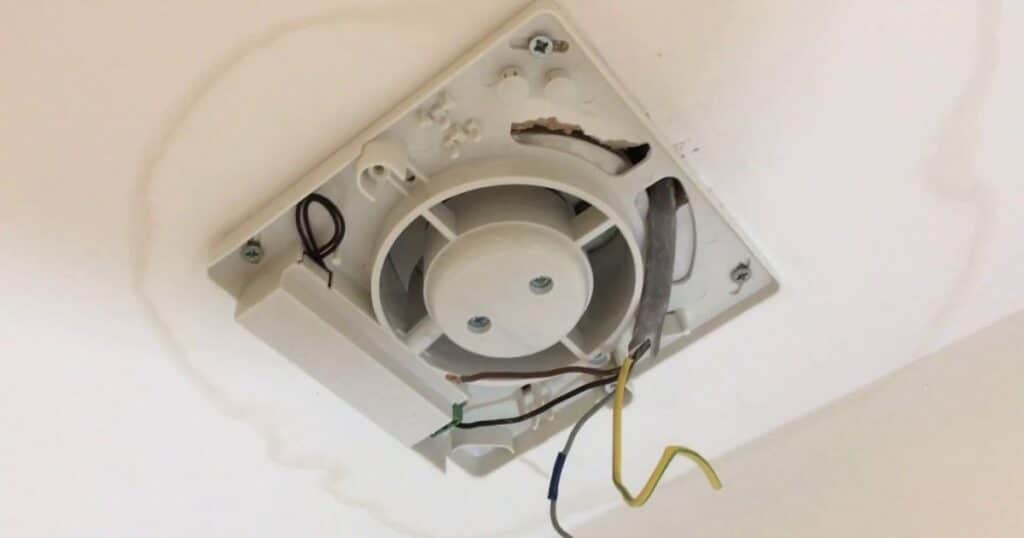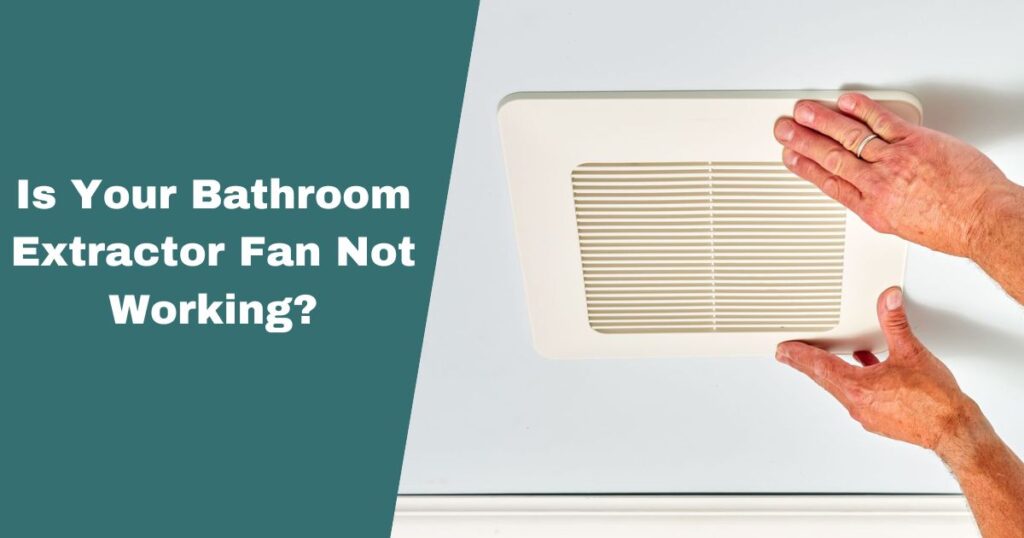Having a functional bathroom extractor fan is crucial for maintaining a fresh, moisture-free environment. When your fan stops working, it can lead to a buildup of humidity, unpleasant odors, and even mold growth over time. Don’t worry; we’ve got you covered with a comprehensive guide to troubleshooting and fixing a broken bathroom fan.
Understanding the Importance of a Functional Bathroom Extractor Fan
A bathroom extractor fan plays a vital role in improving indoor air quality and preventing moisture-related issues. Here are some key reasons why it’s essential to keep your fan in good working condition:
- Moisture Control: Bathrooms are prone to high humidity levels due to steamy showers and baths. An extractor fan helps remove excess moisture, preventing condensation buildup that can lead to mold, mildew, and potential health problems.
- Odor Removal: Bathroom activities can leave behind unpleasant odors. A properly functioning extractor fan helps ventilate the space, removing these odors and keeping the air fresh.
- Building Code Compliance: In many areas, building codes require the installation of bathroom extractor fans to meet ventilation standards. A non-working fan could be a violation.
- Protect Fixtures and Surfaces: Excessive moisture can cause damage to bathroom fixtures, surfaces, and even the structural integrity of your home over time. A working extractor fan helps prevent this by controlling humidity levels.
Primary Causes of a Failed Bathroom Fan
There are several common reasons why a bathroom extractor fan may stop working properly. Understanding these causes can help you troubleshoot and address the issue more effectively.
What causes a bathroom fan to stop working?
- Motor Failure: The fan motor is the heart of the extractor fan. Over time, wear and tear can cause the motor to fail, resulting in a non-functioning fan.
- Dust and Debris Buildup: Bathroom fans can accumulate dust, lint, and other debris over time, obstructing the fan blades and preventing proper airflow.
- Electrical Issues: Problems with wiring, switches, or the electrical supply itself can prevent the fan from receiving power and working correctly.
- Improper Installation or Venting: If the fan was installed incorrectly or the ductwork is poorly designed, it can restrict airflow and cause the fan to underperform or stop working altogether.
Can a bathroom fan burn out?
Yes, it’s possible for a bathroom extractor fan to burn out, especially if it’s been running continuously for an extended period or if there’s a lack of proper maintenance. Here are a few reasons why a fan might burn out:
- Overheating: If the fan motor overheats due to dust buildup or continuous operation, it can cause the motor to burn out and fail.
- Electrical Issues: Incorrect voltage supply or wiring problems can cause the fan motor to overheat and burn out prematurely.
- Age and Wear: Like any mechanical component, fan motors have a limited lifespan and can burn out after years of use and wear.
Electrical Issues Affecting Your Bathroom Extractor Fan

Electrical problems are a common culprit when it comes to a non-functioning bathroom extractor fan. Here are some potential electrical issues to investigate:
- Tripped Circuit Breaker or Blown Fuse: Check your electrical panel to ensure the circuit powering the fan hasn’t been tripped or a fuse hasn’t blown.
- Faulty Fan Switch: The switch that controls the fan may be defective, preventing power from reaching the fan motor.
- Wiring Connections: Loose or damaged wiring connections can disrupt the electrical supply to the fan.
- Incorrect Voltage: Ensure the fan is receiving the correct voltage as specified by the manufacturer. Incorrect voltage can cause the fan to malfunction or burn out.
- Ground Fault Circuit Interrupter (GFCI) Problems: If your bathroom is equipped with a GFCI outlet or circuit, it may need to be reset or replaced if it’s faulty.
It’s essential to exercise caution when dealing with electrical issues. If you’re uncomfortable working with electricity, it’s best to consult a licensed electrician for safety reasons.
How do I fix my bathroom fan?
Fixing a broken bathroom fan can involve various steps, depending on the root cause of the issue. Here are some common troubleshooting and repair methods:
How do you test if a bathroom fan is working?
Before attempting any repairs, it’s crucial to confirm that the fan is indeed not working correctly. Here are a few ways to test your bathroom extractor fan:
- Visual Inspection: Turn on the fan and observe if the fan blades are spinning. If they’re not moving, there’s likely an issue.
- Air Flow Test: Hold a piece of toilet paper or tissue near the fan vent. If there’s no suction or air movement, the fan is not working properly.
- Listen Closely: Turn on the fan and listen for any abnormal noises, such as grinding or rattling, which could indicate a problem with the motor or fan blades.
- Check for Obstructions: Inspect the fan housing and ductwork for any buildup of dust, lint, or debris that could be obstructing airflow.
Fan Motor Replacement
If the fan motor is the root cause of the issue, you may need to replace it. Here’s a general guide for replacing a bathroom fan motor:
- Disconnect Power: Turn off the circuit breaker or remove the fuse supplying power to the fan.
- Access the Fan Housing: Follow the manufacturer’s instructions to access the fan housing, typically by removing a cover or grille.
- Remove Old Motor: Disconnect the old motor from the housing and mounting bracket.
- Install New Motor: Properly mount the new motor, ensuring it’s securely fastened and aligned correctly.
- Reconnect Wiring: Connect the new motor’s wiring according to the manufacturer’s instructions or match the existing wiring connections.
- Test and Secure: Restore power and test the new motor. If it’s working correctly, securely replace the fan housing cover.
Note: It’s essential to follow all safety precautions when working with electricity and refer to the manufacturer’s instructions for your specific fan model.
Preventative Maintenance (AKA Cleaning)
Regular cleaning and maintenance can help prevent many issues with bathroom extractor fans. Here are some tips for keeping your fan in top shape:
- Access the Fan Unit: Follow the manufacturer’s instructions to safely access the fan housing for cleaning.
- Vacuum and Brush Debris: Use a vacuum cleaner with a brush attachment to remove any accumulated dust, lint, or debris from the fan blades and housing.
- Compressed Air: Use compressed air to blow out any remaining debris or hard-to-reach areas.
- Clean Ductwork: If accessible, clean the ductwork leading to the exterior vent to ensure proper airflow.
- Lubricate Moving Parts: If recommended by the manufacturer, lubricate any moving parts, such as the motor bearings, to extend their lifespan.
Regular cleaning can help prevent issues like obstructions, overheating, and premature motor failure, ensuring your bathroom extractor fan operates efficiently for years to come.
DIY Fixes for a Broken Bathroom Extractor Fan

If you’re handy and comfortable working with electrical components, you may be able to tackle some DIY repairs for a broken bathroom fan. Here are a few common DIY fixes:
- Electrical Troubleshooting: If the issue seems to be electrical, you can test and potentially replace faulty switches, repair loose wiring connections, or reset tripped GFCI outlets.
- Fan Motor Replacement: As mentioned earlier, replacing the fan motor yourself can be a cost-effective solution if you have the necessary skills and tools.
- Housing Unit Replacement: In some cases, it may be more economical to replace the entire fan housing unit rather than attempting to repair individual components.
However, it’s essential to exercise caution when working with electricity and follow all safety guidelines. If you’re unsure or uncomfortable with the repair process, it’s always better to consult a professional electrician or contractor.
How to Repair a Bathroom Exhaust Fan That’s Not Working?
- Check Electrical Connections: Ensure all wiring connections are secure and not loose or damaged. Look for any signs of corrosion or burnt wires.
- Test the Fan Motor: If accessible, you can test the fan motor by disconnecting it and connecting it directly to a power source. If it doesn’t spin, the motor likely needs replacement.
- Clean or Replace Components: Depending on your findings, you may need to clean the fan blades, housing, and ductwork to remove any obstructions. If the motor or other components are damaged, you’ll need to replace them.
- Refer to Manufacturer Instructions: Consult the manufacturer’s instructions for your specific fan model when replacing components or reassembling the unit.
- Consider Professional Help: If the issue seems complex or you’re uncomfortable working with electrical components, it’s best to consult a professional electrician or HVAC technician.
Visual Guide and Video Tutorial
For visual learners, here’s a helpful video tutorial demonstrating the process of repairing a bathroom exhaust fan:
Additionally, refer to the diagrams and illustrations in your fan’s instruction manual for a clear visual reference during the repair process.
Must-Have Tools and Supplies
To tackle a bathroom fan repair, you’ll need the following tools and supplies:
- Screwdrivers (flathead and Phillips)
- Wire strippers/cutters
- Voltage tester or multimeter
- Replacement fan motor (if needed)
- Duct tape or foil tape
- Cleaning supplies (vacuum, brushes, compressed air)
- Ladder or step stool (if needed for access)
Safety Precautions
Working with electrical components can be hazardous if proper safety measures aren’t taken. Here are some essential safety precautions to follow:
- Always turn off the power source before working on the fan.
- Use insulated tools and wear non-conductive gloves.
- Follow all manufacturer instructions and local electrical codes.
- If you’re unsure about any part of the repair process, don’t hesitate to call a professional.
How to Stop a Draught from a Bathroom Extractor Fan
While a bathroom extractor fan is designed to remove stale air and moisture, it can sometimes cause unwanted drafts or cold air intrusion. Here are some tips to help stop drafts from your bathroom fan:
- Seal Leaks and Add Insulation: Inspect the area around the fan housing for any gaps or cracks that may be allowing drafts. Use caulk or insulation foam to seal these leaks effectively.
- Install Back-Draft Dampers: A back-draft damper is a flap or valve that prevents outside air from entering the ductwork when the fan is off. Installing one can help prevent drafts.
- Adjust Louvers or Install Vent Covers: If the exterior vent louvers are not functioning correctly or are missing, adjust or replace them to prevent outside air from entering.
- Improve Ductwork Insulation: Inadequate insulation in the ductwork can allow temperature transfer, causing drafts. Consider adding insulation wrap or replacing poorly insulated sections.
- Consult an HVAC Professional: If you’ve tried the above solutions and still experience persistent drafts, it may be time to consult an HVAC professional. They can diagnose and address any underlying issues with your ventilation system.
Addressing drafts from your bathroom extractor fan can not only improve comfort but also enhance energy efficiency by preventing unwanted air exchange.
Final Thoughts
A properly functioning bathroom extractor fan is essential for maintaining a fresh, moisture-free environment and preventing potential issues like mold growth, structural damage, and unpleasant odors. By understanding the common causes of fan failure, testing methods, and repair techniques, you can take proactive steps to keep your fan in top working condition.
Remember, regular cleaning and maintenance can go a long way in preventing many issues and extending the lifespan of your bathroom fan. However, if you encounter complex electrical or installation problems, it’s always best to consult a licensed professional for safety and peace of mind.
Investing in a high-quality, properly installed bathroom extractor fan can not only improve indoor air quality but also add value to your home. By following the tips and guidelines outlined in this article, you can ensure your bathroom remains a fresh, comfortable, and healthy space for years to come.
Frequently Asked Questions
How do I know if my extractor fan is not working?
Look for a lack of airflow or suction near the fan vent. Listen for any abnormal noises like grinding or rattling. Inspect for a buildup of dust/debris obstructing the fan blades.
Why do bathroom extractor fans stop working?
Common causes include motor failure due to age/wear, dust buildup restricting airflow, electrical issues with wiring/switches, and improper installation or venting problems.
Why is my bathroom extractor fan not extracting?
It could be due to clogged vents or ductwork, a faulty fan motor, incorrect installation obstructing airflow, or electrical issues preventing the fan from receiving power.
How do I know if my bathroom fan is not working?
Turn the fan on and visually check if the blades are spinning. Use a tissue paper to test for lack of suction/airflow near the vent. Listen for strange operational noises.
What to do if the extractor fan is not working?
First, inspect for clogs, electrical faults, or installation issues. You may need to clean, repair wiring, replace the motor, or hire a professional for complex fixes.
Why is my extractor fan not doing anything?
It could be a tripped circuit breaker, faulty switch, loose wiring connections, incorrect voltage supply, or a completely burnt-out motor requiring replacement.







